Thirteen years of exciting racing around a little-known street circuit in Asia.
Words by Eli Solomon. Images from Rewind Media’s Archives
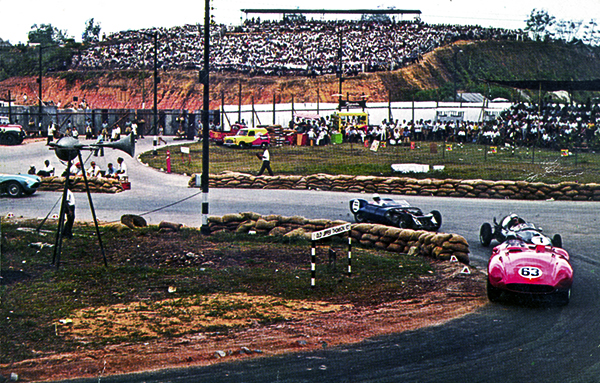
A postcard from Singapore…from the inaugural Singapore Grand Prix (1961). [see Sembawang Hill Circus]
2023 marks the 50th anniversary of the last Upper Thomson Road Grand Prix in Singapore (1973) so it’s perhaps a fitting tribute to this once iconic race that Rewind Media puts out a short piece about the Grand Prix that ran for 13 years (1961-1973). There’s a great deal of detailed first-hand local content on social media, so here’s an advanced apology for flying over Singapore’s air space once more. I have added a number of relevant links within that should mitigate the lack of detail within this article.
It was lovely and fast flowing, a wonderful and challenging circuit, and so gratifying when you manage to put it all together. You never ever thought, ‘Ooo’, what if I go down there [the monsoon drains]?’
Australian Vern Schuppan, unfazed by all the hype around monsoon drains around a street circuit, was the last winner of the Singapore Grand Prix.
The first Singapore Grand Prix, held around the Upper Thomson and Old Upper Thomson Road in 1961, consisted of a Grand Prix for Sports and Racing Cars and just eight support races, including Grand Prix for motorcycles. By the last Grand Prix in 1973, the Grand Prix weekend featured a total of 14 races with main events for motorcycles and single-seater racing cars [see The Orient Year Grand Prix]. Imagine hosting 14 supporting events and two Grands Prix today.
When the Sports and Racing Car race was first run in 1961 as the main race, there was negligible prize money. When the last race was held in 1973, first place in the Grand Prix paid SGD10,000 (~£1,700) and the organisers paid “starting money” to the racers. Much to the chagrin of the local enthusiasts, a large percentage of the grid was invited from overseas.
On two occasions did the large-engine Sports Car come out tops – planter Ian Barnwell’s Aston Martin DB3S in 1961 and Singapore’s Yong Nam Kee’s Jaguar E-Type Roadster in 1962. Reliability ruled over 180 miles of racing in 1961 and 1962.
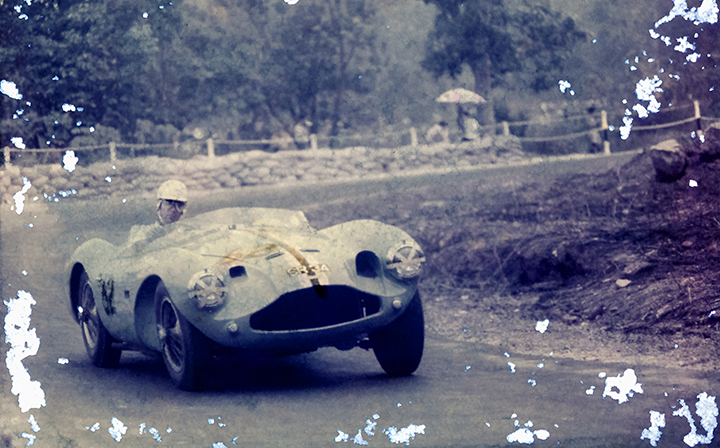
Rare colour slide from the 1961 Singapore Grand Prix showing Ian Barnwell in his Aston Martin DB3S/106 [see For The Price of A House]
A PERSPECTIVE
The fastest lap of the circuit in the first Singapore Grand Prix of 1961 was 2 minutes 47 seconds, set by Chan Lye Choon’s Lola Mk1 Climax FWE (with long range fuel tanks installed) [see Tropical Lolas]. But it was Barnwell’s Aston Martin DB3S, winner of the Changi (1957) [see Landing at Changi] and Macau Grand Prix (1958) that finished first [see For the Price of a House]. When the last race was run in 1973, Australian Leo Geoghegan had lowered the time to just 1 minute 54.9 seconds in his Australian-made “light as a feather” Birrana 273. The fastest car in 1973 would have out-lapped the fastest car of 1961 on every third lap! Engine output had doubled from around 77 bhp per litre for the 2922cc Aston Martin DB3S in 1961 to 150 bhp per litre by the time Australian Vern Schuppan won in his March 722 (which had revised wide-track suspension installed by March’s designer Denis Falconer) in 1973 [see Rides of March – Part 1].
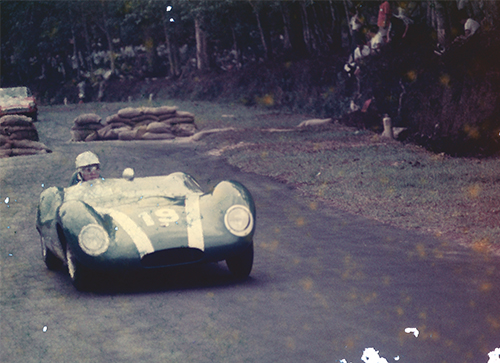
This Lola Mk1 FWE (using the Lotus Elite’s FWE Coventry Climax motor) was successful in the 1961 Johore Grand Prix, which preceded the Singapore event. Its owner was 1957 Changi Circuit Races and 1958 Macau Grand Prix winner, Chan Lye Choon. [see Tropical Lolas for a history of this car in Asia]
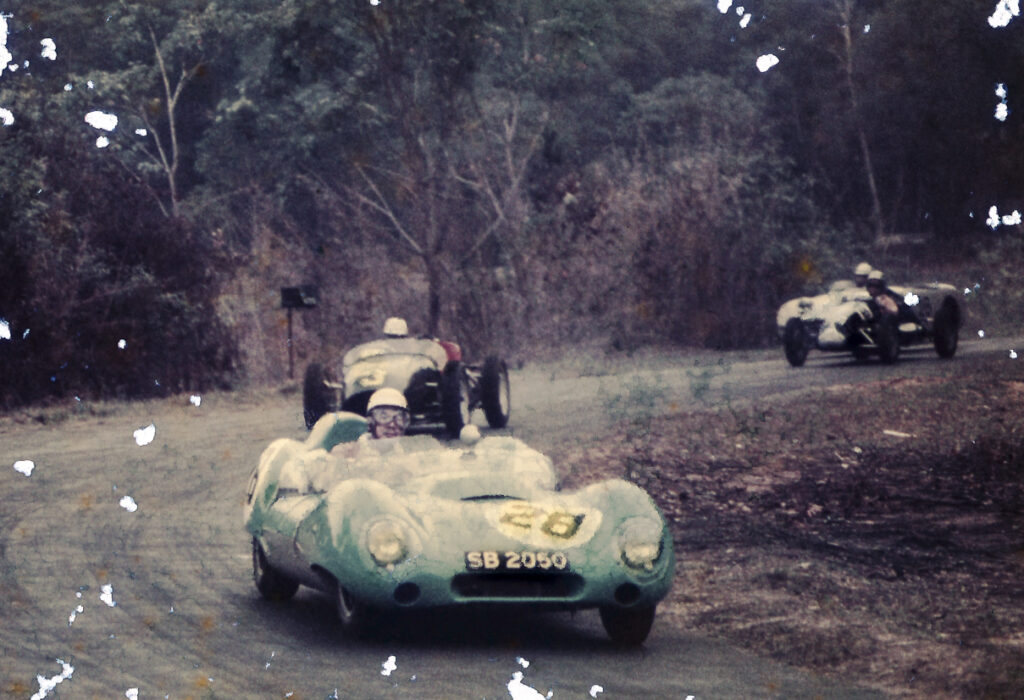
Stanley Leong’s answer to the domination of Lotus Elevens was to import this Lotus 15 (Chassis 605) and shoehorn his 2-litre Ferrari motor (purchased from George Baker in Hong Kong) and call it the Ferratus. Photo from the 1961 Singapore Grand Prix.
The fastest lap of the circuit in the first Singapore Grand Prix of 1961 was 2 minutes 47 seconds, set by Chan Lye Choon’s Lola Mk1 Climax FWE (with long range fuel tanks installed). But it was Barnwell’s Aston Martin DB3S, winner of the Changi (1957) and Macau Grand Prix (1958) that finished first.
The first Grand Prix race in 1961 was run as Formula Libre for Sports and Racing Cars, permitting all manner of cars: Cooper Double-Knocker Nortons, Austin and Morris Minis, E-Type Jaguars, an ERA R2A, and the locals Specials such as the Ferratus and the Bamboo Special [see Bamboo & Buckler]. The first major rule change arrived in 1971 with engine capacity and valve train limited to 1600cc and two valves per cylinder respectively for Grand Prix cars. Sports Cars were still permitted but discouraged, limited to a maximum of 2-litres. This eliminated the big-banger Can-Ams and Formula 5000s because the twisty circuit was simply incapable of handling the ground-pounders. Nor was the poultry spared either. It was a well-known phenomenon amongst the plantation dwellers of Upper Thomson Road that their chickens lodging in the farms dotted along the circuit would throw their wings up in despair, issue a protest with a unified cluck and promptly stop laying eggs two weeks before each race weekend.
DEVINE INTERVENTION
The first five years were dominated by sports cars, the exception being 1964, when the race was aborted due to calamitous weather while a young Rodney Seow was showing how it should be done in his ex-Works Merlyn Mk5/7 single-seater.
It seemed that the single-seater would rule the roost as horsepower to weight ratios rose, even if it were only the denominator that was plunging. When the locals found the time to test around the circuit, the chickens lodging at poultry farms around flung their wings up in despair, protested and promptly stopped laying eggs. Even the heavens were not cooperating and come Easter Monday, everything went wrong.
The 1961 winning Aston Martin DB3S eliminated itself and its driver in practice; a course marshal lost his life; and even before the starter could unfurl his flag and hour and a half after the scheduled start, the favourite, in a Lotus 22, had an off in his enthusiasm, rear trailing arms bent. Frantic jumping on the bent bars made little difference and the car was out cold, leaving the Merlyn to battle it out with a Police Inspector’s Lotus 23 and a former British Hill Climb champion’s Brabham BT8 Climax. By the fifth lap, three of the faster cars had been wrecked, all along “Murder Mile”, the infamous stretch leading to the Circus Hairpin. Mercifully, the death toll that weekend amounted to just two, and one other injured top Japanese rider who would not ride again. This was motor racing on a street circuit in the 1960s.
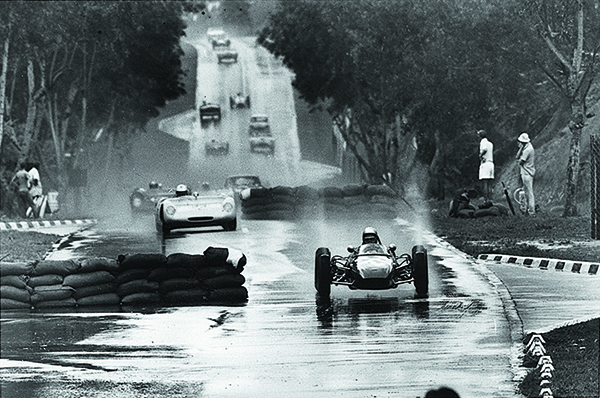
A very evocative shot of Thomson Mile (aka Murder Mile) as the car approach Sembawang Circus for the right hander and Old Upper Thomson Road. Rodney Seow streaks ahead in his Merlyn Mk5/7 during the 1964 Grand Prix. Behind him is Albert Poon in his Lotus 23. Said Rodney Seow of the fuel tanks on is Mk5 Merlyn: “Oh, these long range fuel tanks…they are hazardous, you’ve got one under the seat, two on the side, one on top by the dash.”
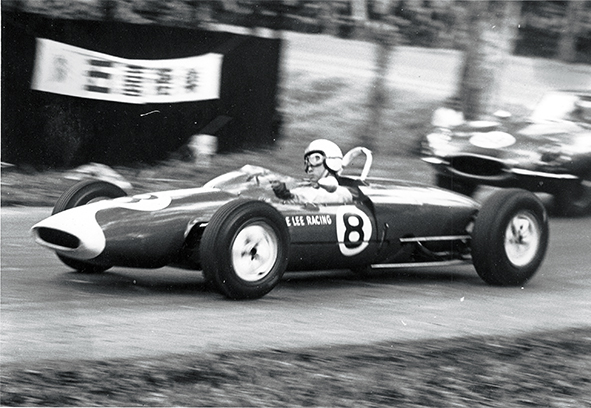
Lee Han Seng was the local hero when he took his Lotus 22 to victory in the 1966 Singapore Grand Prix against stiff opposition from Australian Greg Cusack, Hong Konger Albert Poon, and Singaporean Rodney Seow.
THE MULTI WINNERS
Over the thirteen Grand Prix years, Lotus cars chalked up the most wins of any manufacturer with three Grand Prix victories in 1963, 1965 and 1966, a Lotus 23 and 23B and a Lotus 22 single-seater. After 1966, no manufacturer won the coveted Grand Prix trophy more than once. By 1973, Lotus cars had achieved twelve overall race wins, counting the various support races. Ford-derived engines dominated the entire period, winning in all but 1961, 1962 and 1971. In all but the 1961, 1962 and 1971 races, four-cylinder engines triumphed.
Graeme Lawrence
Developing and driving his McLaren M4A FVA for 1969 was, to quote the Kiwi, was “Like trying to dance with an octopus on a tight wire”.
Two drivers enjoyed multiple wins in the Grand Prix. Kiwi Graeme Lawrence [see The Summer of ’69 and the Inverted Wing] triumphed three years running, in 1969, 1970, and 1971, and may have made it four out of four had he not missed the event in 1972 due to injury. It was not a stroll in the part for the very likable triple-double winner. Developing and driving his McLaren M4A FVA for 1969 was, to quote the Kiwi, was “Like trying to dance with an octopus on a tight wire.” Battling fellow Kiwi Roly Levis’ bi-winged Brabham BT23C that year was no easy task, the Brabham the faster car over both the Selangor and Singapore weekends. Aero-aids were the in-thing, and neither the Porsche Carrera 906 Spyder [see Beyond Just a Spyder], the Lola T70 Spyder, or the Cosworth-developed Brabham BT10 [see Costin’s Mule] could touch it [see The Summer of ’69 and the Inverted Wing]. Lawrence not only won the Singapore Grand Prix but the Selangor Grand Prix at Shah Alam as well, the first of his triple-doubles. Gone was the gentleman racer and clubman atmosphere; racing was serious business for the driver and for the country hosting a race.
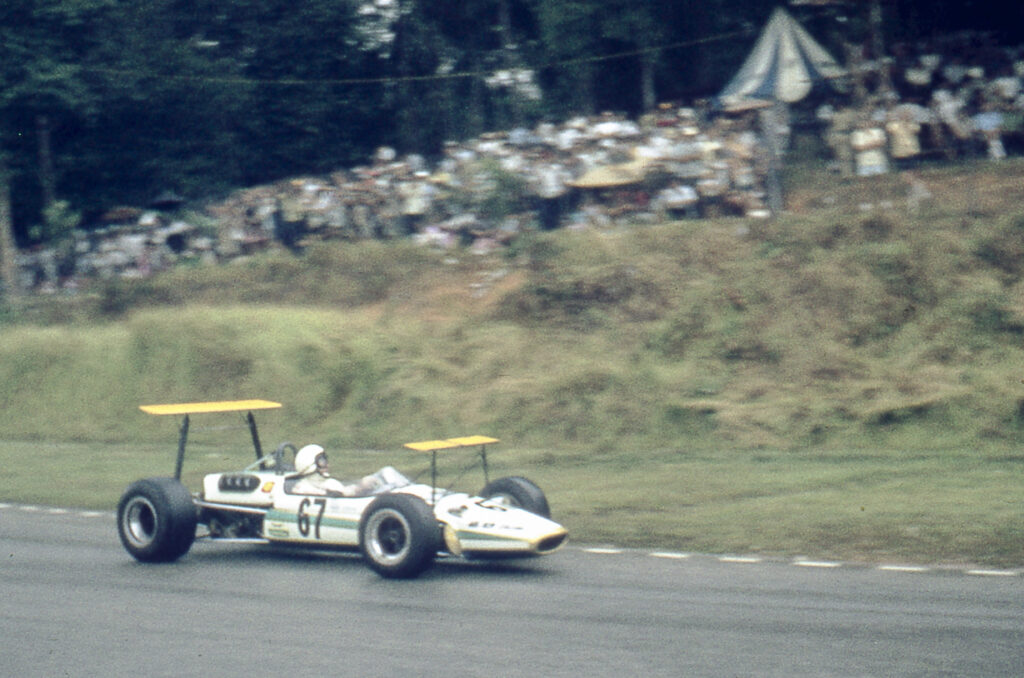
A dawn of aerodynamics…with Roly Levis’ Brabham BT23 and his bi-wing configuration. Yes, it was fast, and it set FTD at Batu Tiga and Singapore in 1969. The photo shows Levis and his BT23 along Upper Thomson Road during the 1969 Singapore Grand Prix.
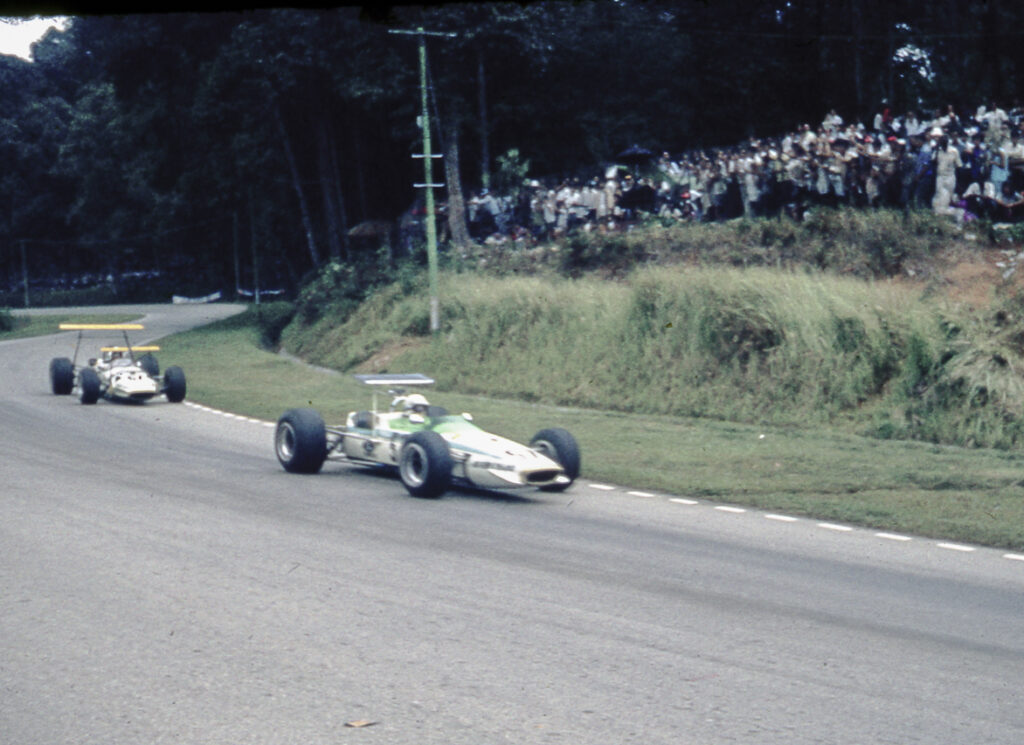
Kiwi domination – in 1969, 1970 and 1971! The photo shows Graeme Lawrence (McLaren M4A FVA) leading Roly Levis (Brabham BT23C FVA).
Albert Poon
“Old John Mac never used to eat at the police mess. I was an instructor, so one day I went over and asked him why. He said he was saving money. `What for?’ I asked. He said it was for a race car. `Ah, you want to race.’ `Yes, so I can beat you,’ came Macdonald’s reply”.
Hong Kong Police Inspector turned Alfa Romeo importer Albert Poon won twice, in 1963 and 1965 [see Casebook of 23s]. Poon also dominated the Saloon & Tourer races as well, winning on four occasions. Poon recalls what John Macdonald, one of Asia’s top racing drivers throughout the 1960s and 1970s said: “Old John Mac never used to eat at the police mess. I was an instructor, so one day I went over and asked him why. He said he was saving money. ‘What for?’ I asked. He said it was for a race car. ‘Ah, you want to race.’ ‘Yes, so I can beat you,’ came Macdonald’s reply. There was serious competition, even amongst friends.
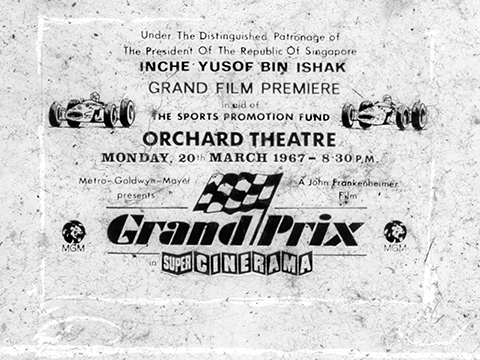
A very rare invitation flyer for the premier in Singapore of the iconic Frankenheimer epic Grand Prix.
CARS THE STARS
Over the 13 years of the Grand Prix, many interesting and internationally known cars made it to Singapore for the annual Grand Prix. Many were already in the region, owned by members of the Commonwealth forces and planters, Lotus Elevens [see Super Friendly, Super Frail], ERAs, a Ferrari Tipo 500 [see Just The Right Amount of Torque], a Warrior Bristol [see Jungle Warrior], an Aston Martin DB3S [see For the Price of a House] , a Jaguar D-Type and XK Jaguars and many others. Many had prior international race history, such as Barry Swann’s ERA R2A, Richard Wong’s Porsche 906, Graeme Lawrence’s Ferrari Dino 246T and John Macdonald’s Brabham BT10, known affectionately to many as “Costin’s Mule” [see Costin’s Mule]. Others were adaptations and home-built Specials [see Monsters & Mavericks], very popular in the region throughout the 1950s.
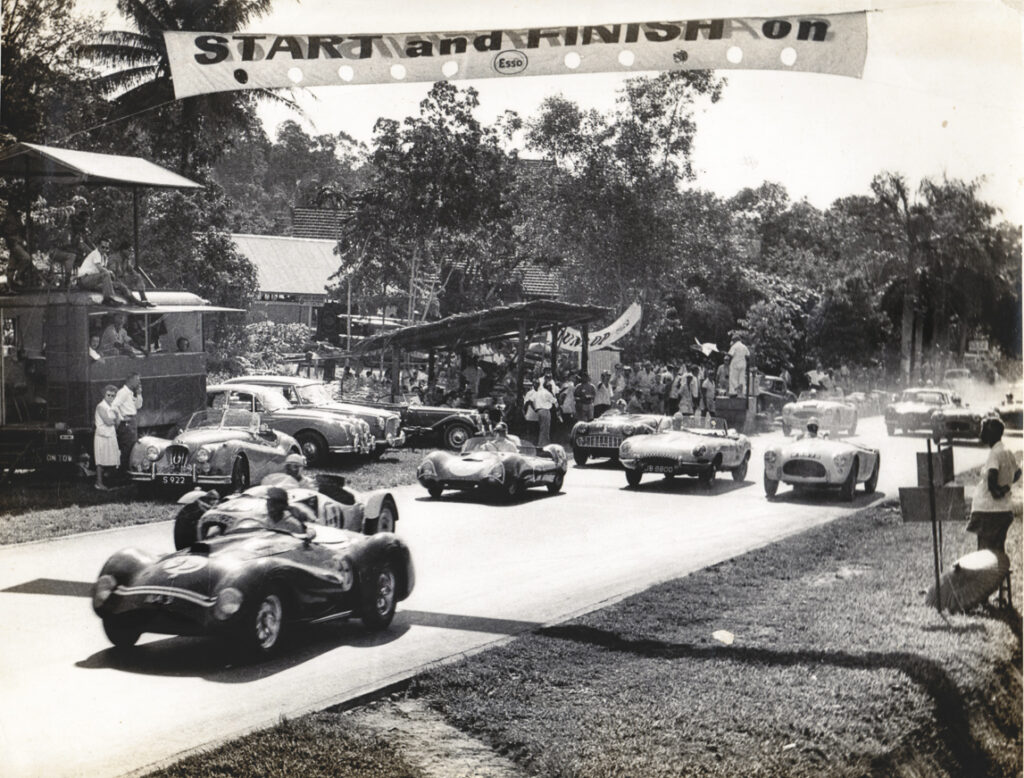
Sports and GT cars support race to the 1962 Grand Prix in Singapore. At the front is Bernard Arnold in his blue with double white band Ecurie Ecosse D-Type-livery-looking Warrior Bristol/Cooper Jaguar. Behind Arnold is Robert Lee in his Robert Lee Special (No.47), Peter Heath in his Lotus 15 Climax (No.54), Freddie Johns in his E-Type Jaguar (No.36) and Lam Theng Pew in his ex-Barry Swann AC Ace (No.87). The Lotus 15 won this race with Arnold second.
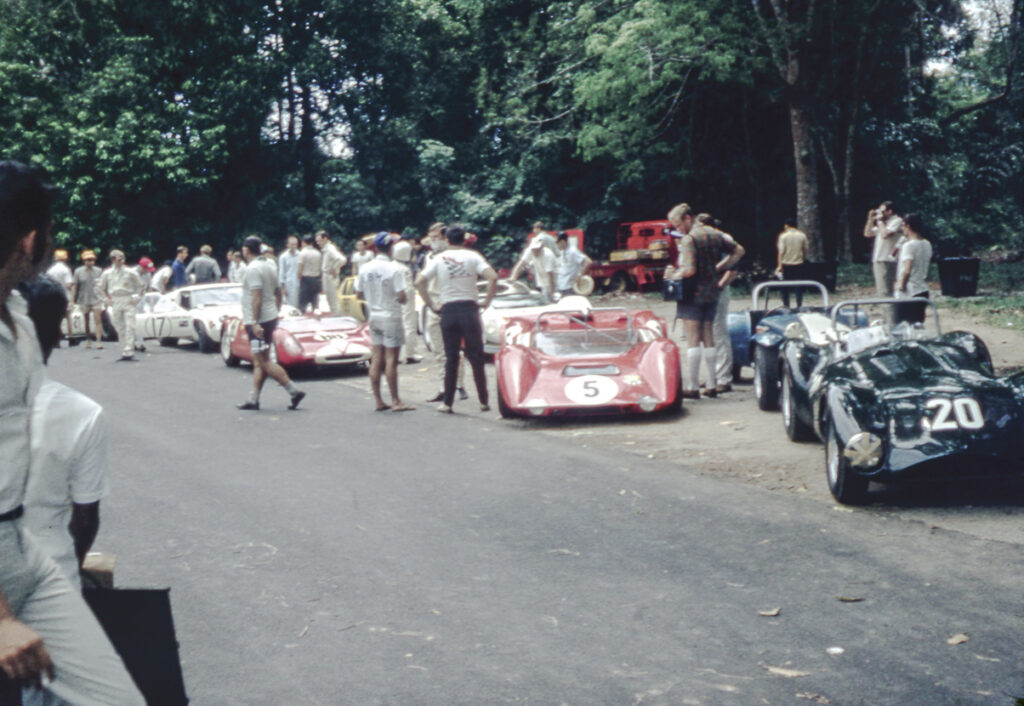
Sports cars galore in Singapore in 1969. No.20 is the Warrior Bristol (now called the Cooper Jaguar). Alongside in the No.5 is an Elfin 300. Look closely and you’ll see a Lotus 47 in the background.
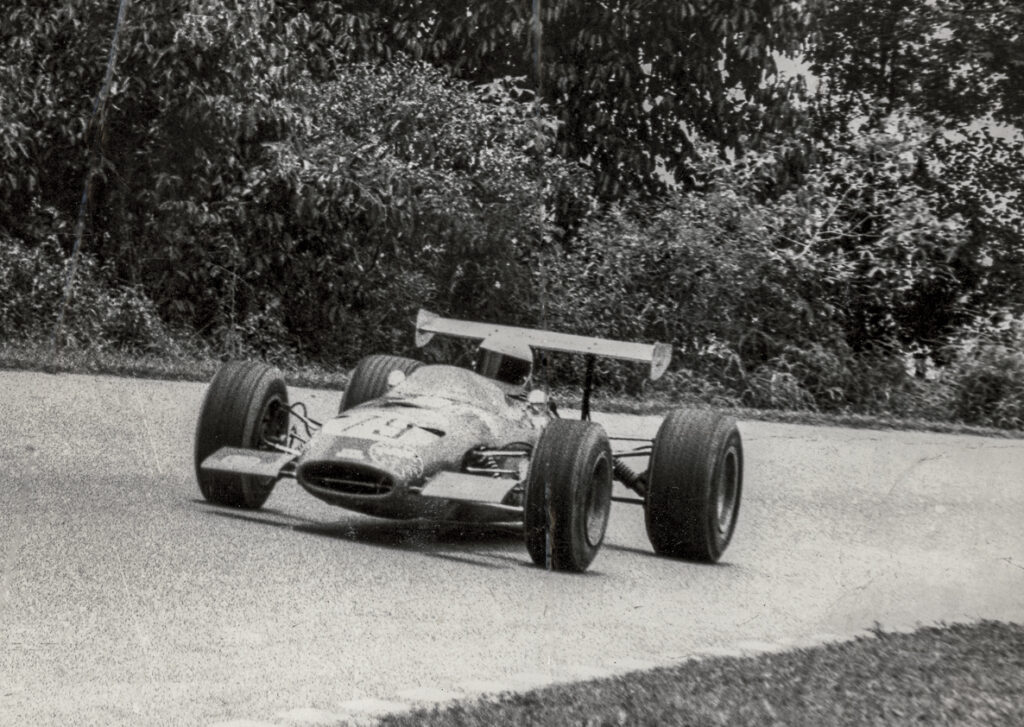
John Macdonald’s Brabham BT10 – complete with both front and rear aerofoils in Singapore. [See Costin’s Mule for the story of this car]
One such adaption originated from a Lotus 15, imported from the UK. Mindful that the Lotus Elevens and Lola Mk1s were starting to dominate local racing, architect Stanley Leong abandoned his Ferrari 2-litre-engined S.L. Ferrari (an MGA-chassis TR250-lookalike) in favour of an early Lotus 15. In went the temperamental 2-litre 4-cylinder Ferrari Mondial engine along with the MGA gearbox. The troublesome and short-lived Lotus-Ferrari instantly became the Ferratus [see Monsters & Mavericks].
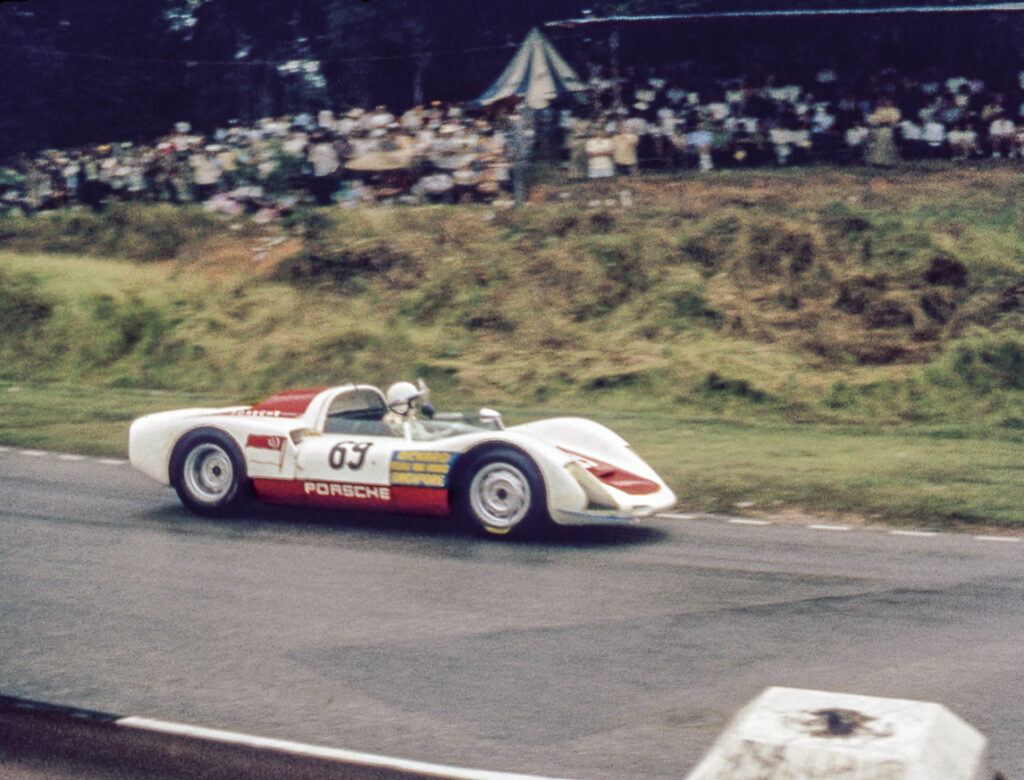
Richard Wong and his 906 in Singapore in 1968. What an amazing sound that flat-six made. Albert Poon described it as “A terrific car”.
The ex-Alan Hamilton Porsche 906 Spyder [see Beyond Just a Spyder] which local industrialist Richard Wong imported was said to be the most expensive car on the island in 1968, and one of the fastest when it arrived on Singapore’s shores. Albert Poon occasionally drove for Wong and recalled that it was, “A terrific car. At that time, when you were using all these lousy Lotus, here comes a Porsche. My God, it out-corners the Lotus. It has so much power. Normally you put your foot down…Brmmmmm 7-grand, change gear, brmmmmm 7-grand. This car, you put your foot down…zip 7-grand, zip 7-grand. Quad-cam engine. Beautiful!” Sadly, it arrived just as aerodynamics lowered single-seater benchmarks beyond what the Sports Car was capable of around Upper Thomson Road.
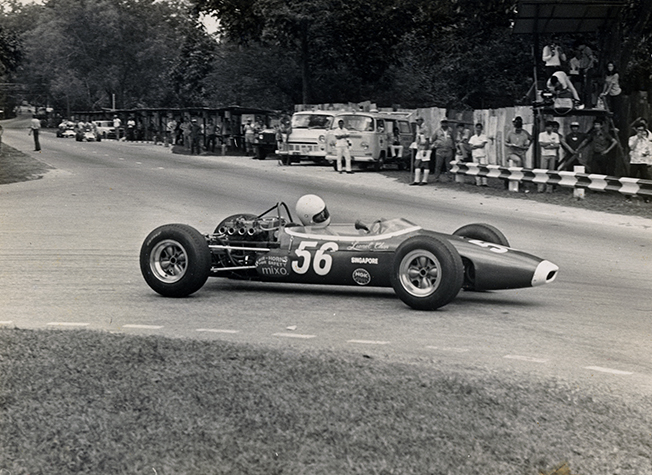
Up and coming local race Lionel Chan had progressed from bikes to saloons to the ex-Rodney Seow Merlyn Mk5/7 before settling on this Brabham. His career tragically ended at the 1972 Singapore Grand Prix in an unfortunate accident in this Brabham at Long Loop.
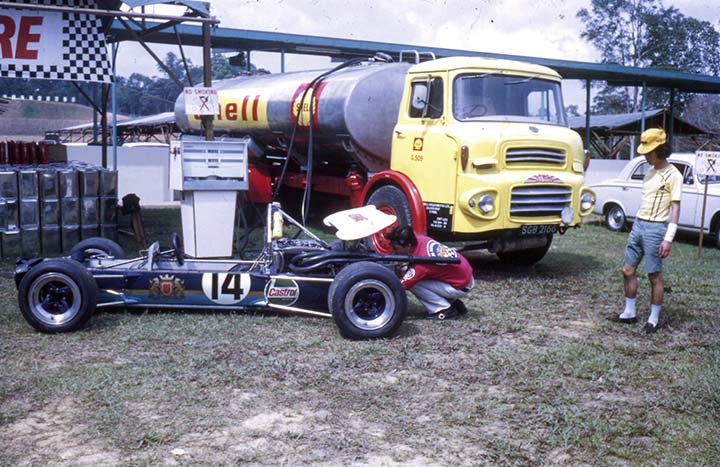
Refuelling in the paddock for the Singapore Grand Prix. Rothmans of Pall Mall were just starting to dip their feet into sponsoring local drivers (such as Jan Bussell and his McLaren M4C).
Brabhams were also a popular choice when it came to racing in South East Asia. During the decade between the late 1960s and 1970s, Brabham race cars amassed over 20 outright Grand Prix wins in Macau, Penang, Philippines, Selangor and Singapore, a phenomenal record for any one race car manufacturer. John Macdonald’s Brabham BT10 was one of nearly 30 examples that raced in Asia, a car that had been successfully campaigned by Brian Hart, Mike Costin and Chris Meek before Macdonald raced it in Singapore in 1969. “Costin’s Mule” required some fettling before it was tropicalised for the local clime. Macdonald was never short of a good quote. “Do you want to be safe or do you want to race!” he remarked on the installation of the additional aluminium fuel tanks on the sides of the car. “When we got the car the underbody just weighed a bloody ton and a half… How light can we get it? We’ve got to compete with Birranas and the like. So in the end we threw it [the underbody] away and made one up out of aluminium.”
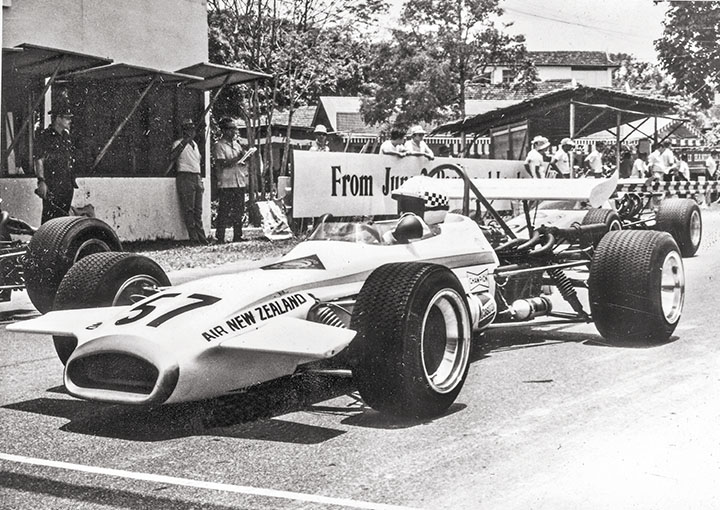
The most successful racing driver in Asia between 1969 and 1971 was Kiwi Graeme Lawrence, seen here in his Brabham BT29 at the 1971 Singapore Grand Prix.
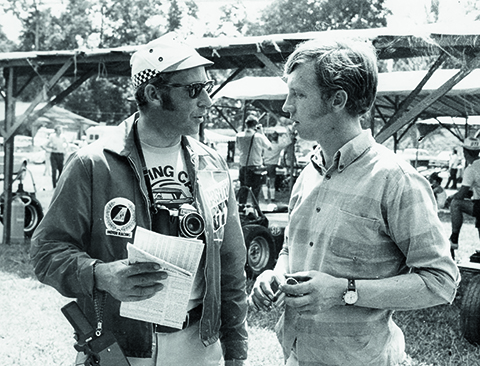
Racing Car New’s Editor Max Stahl and aspiring Formula 1 racer Vern Schuppan at the Paddock ahead of the 1972 Singapore Grand Prix. Vern would go on to much bigger things (including winning the final Singapore Grand Prix in 1973 – see Part 1 of Rides Of March)
There were Australian cars that few had heard of as well, like the first Birranas designed by Tony Alcock (who later worked for Graham Hill’s Embassy Formula 1 team). Malcolm Ramsay’s Birrana was, as Macdonald remarked, “light as a feather, a bit of lightness added and we didn’t realize how much lightness was added until we saw the bullet holes in front of Malcolm’s car… The marbles, presumably kicked up by a car in front, went straight through Malcolm’s car…The car was full of holes…as if somebody had levelled a sub-machine gun against it.” Leo Geoghegan’s Birrana 273-007 set the course record around the Singapore Grand Prix circuit in 1973.
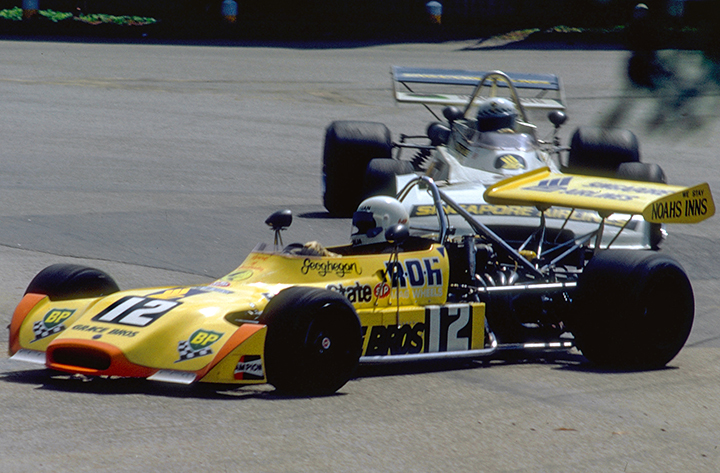
Leo Geoghegan in the Birrana 273-007 leads Graeme Lawrence in the Surtees TS15 Hart during the 1973 Singapore Grand Prix. Lawrence finished second to Vern Schuppan and his March 722 while Geoghegan finished ninth. However, Geoghegan and the Birrana set the all this course record for the Upper Thomson Road circuit with a 1:54.9 (94.71 mph)on the 9th lap of the Grand Prix.
SUPERB ORGANISATION
Albert Poon always had praise for the organisers of the local Grand Prix. “The Singapore Grand Prix, I tell you, is the best-organised race meeting in all my life. On arrival at the airport, there’s always somebody there to meet you. The organisation was superb; the conditions were appalling. We knew exactly what was going on; the races started exactly on time. The paddock was muddy, no shade whatsoever. Hot. But well-organised. No hassles from the customs. The first time I had the Lotus 23…they let me test the car on the road… I drove it around town with trade plates taped to the body. They said, ‘Why don’t you just drive the car back to the hotel?’” Graeme Lawrence had a similar story to tell of his McLaren M4A.
There was a downside to street circuits such as the Upper Thomson Road Circuit. “Every year, somebody got killed… Every year! Without fail! Absolutely unbelievable! Anywhere on the circuit! One time on the straight, one time at the chicane, one time up on the hill. And this time [1972], the Government says that if somebody gets killed, no more Grand Prix. Everybody’s been briefed not to kill ourselves,” said Poon, with a straight face.
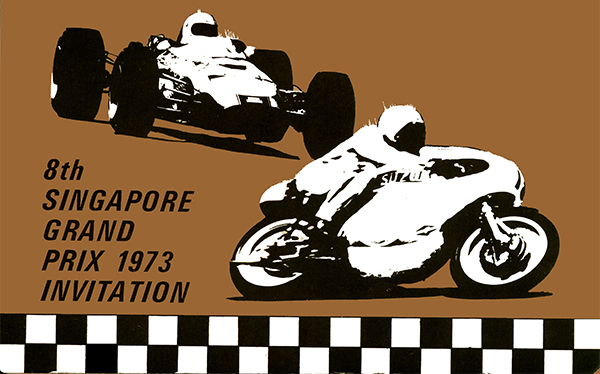
An official invitation to the 1973 Singapore Grand Prix.
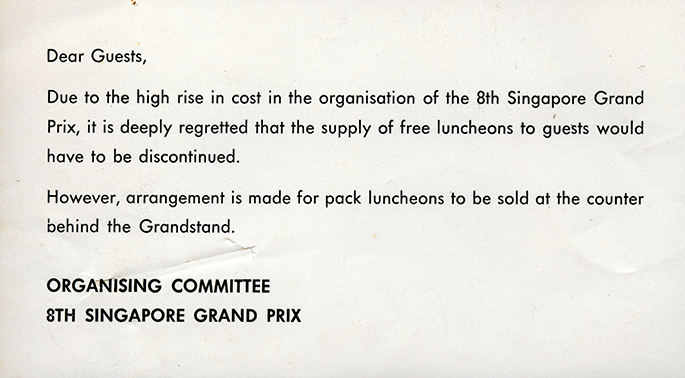
Possible harbinger of things to come…this was in the first quarter of 1973.
Dickie Arblaster, a keen promoter of the sport in Singapore and one who always extended support to the international competitors between his radio and TV commentary duties, felt that they had been “running a successful meeting for thirteen years, so the whole organisational infrastructure was there, you just flicked the switch, everybody knew what they’ve got to do, it wasn’t like starting from scratch as it had been in 1961 when it was…a slog.”
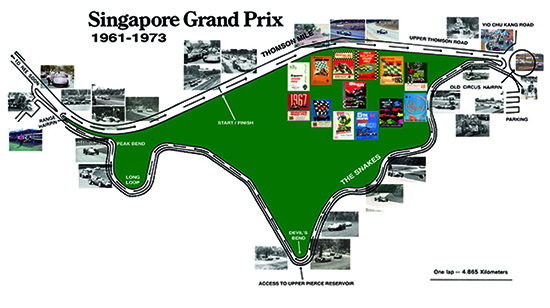
The Upper Thomson Road Circuit – virtually unchanged between 1961 and 1973.
Written by Eli Solomon
Images from Rewind Media’s Archives
Note from the writer: This is a short account of the Singapore Grand Prix. I haven’t included the motorcycles and many of the well-known names have been omitted in order to keep this piece reasonably short. If you want to know more about the history of the Singapore Grand Prix, check out books on the subject – such as Snakes & Devils – A History of the Singapore Grand Prix. I have a few copies left in my office. Contact me if you’d like to purchase a copy.

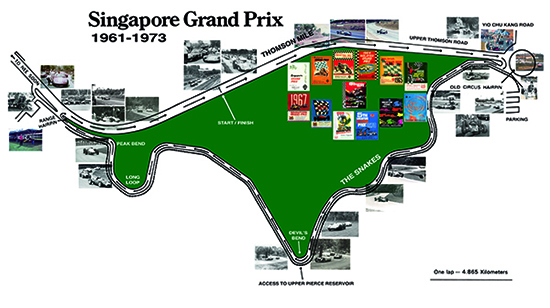
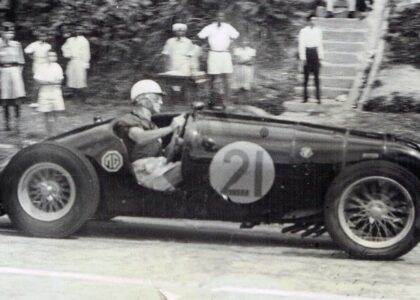
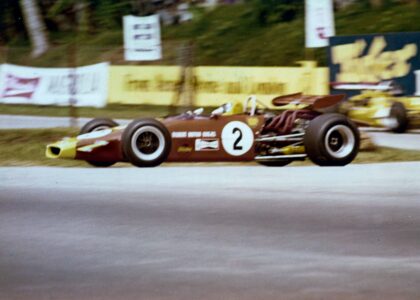
Hello Eli!
I am very interested in getting myself a copy of Snakes and Devils, as well as following your content! May I know if it’s still possible to get a book!
Cheers
Bradley